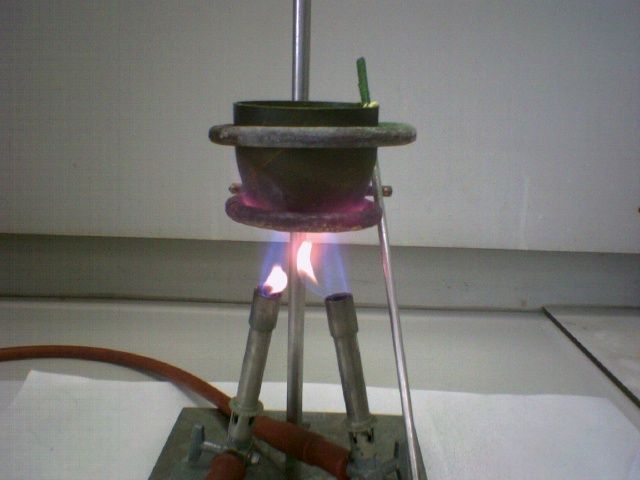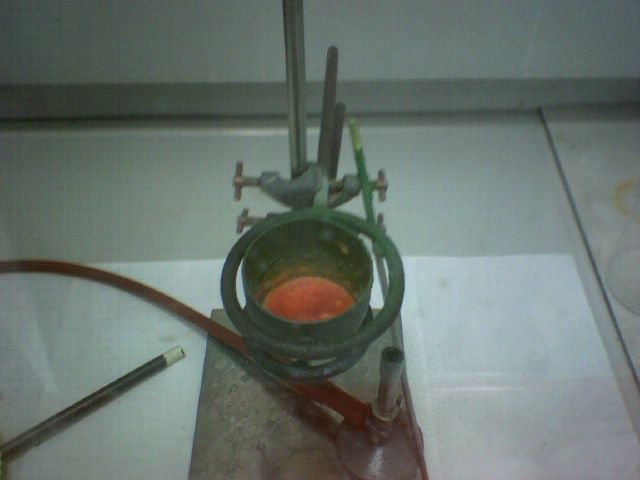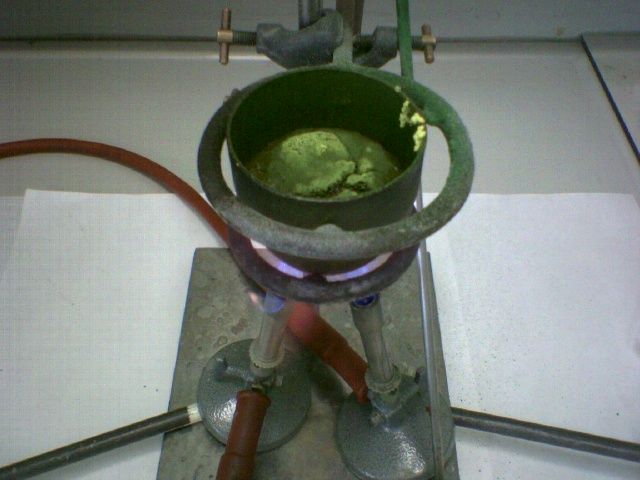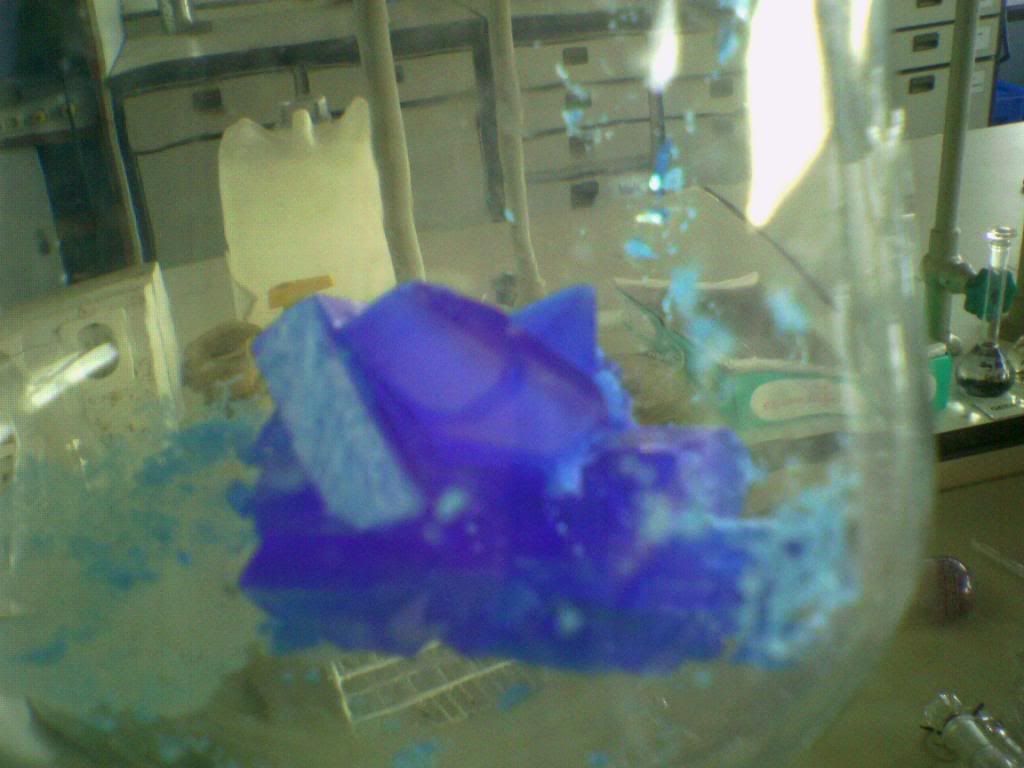
Chyros' chemistry thread
#151
Posted 01 June 2013 - 13:59
#152
Posted 01 June 2013 - 16:40
Time for another experiment. The synthesis of potassium dichromate, which is an extremely orange solid that is green during synthesis. For this, we use almost alchemical equipment; two Bunsen burners and a metal crucible.
First, the chemicals are added to the crucible and heated quite a lot. The heat is enough to actually melt some of the crucibles every time despite them being mate out of cast iron which can take quite a lot:

The chemicals then change colour and start to rise and fall as if it were alive:


Finally the crucible is cooled down and an aqueous extraction is performed.

The result is deep orange crystals that look like this:

The brave hide behind technology. The stupid hide from it. The clever have technology, and hide it.
—The Book of Cataclysm


#153
Posted 13 September 2013 - 22:45
Do salt crystals form following a certain pattern, or do they randomly grow? I'm doing a geometric study of salt crystals and small-scale salt formations, formed as evaporites in a seasonal desert lake, and the salts I'm investigating are presumably (from wiki) sodium chloride, sodium carbonate and sodium bicarbonate.
#154
Posted 13 September 2013 - 23:45
Admiral FCS, on 13 September 2013 - 22:45, said:
Do salt crystals form following a certain pattern, or do they randomly grow? I'm doing a geometric study of salt crystals and small-scale salt formations, formed as evaporites in a seasonal desert lake, and the salts I'm investigating are presumably (from wiki) sodium chloride, sodium carbonate and sodium bicarbonate.
That depends. Some salts are crystalline, which means they have an ordered structure, others are amorphous, which means they grow in random directions and are unordered. Most salts are crystalline, the structure of which can be described by one of the Bravais Lattices (http://en.wikipedia....Bravais_lattice) which describe a crystal system (http://en.wikipedia..../Crystal_system); a few, like sand-like silicates, are amorphous, which can't be described with any crystal structure. The salts you describe are all crystalline under normal conditions; NaCl is isometric hexoctahedral (Oh), sodium carbonate is monoclinic domatic (C1h) and sodium bicarb is monoclinic prismatic (C2h). When solutions of these salts evaporate, a process called "nucleation" occurs: as the solution becomes supersaturated; tiny crystals crash out of solution. As these are thermodynamically bound to form the most energetically favourable conformation of atoms, these tiny nuclei are ordered in geometry. Then, according to a principle called Ostwald ripening, instead of more small nuclei forming, these tiny crystals will instead grow, because this is more thermodynamically favourable. As such, these crystals will grow, and in the same geometry as the mother nucleus, because this is the only thermodynamically allowed arrangement for crystals. As such, if you grow any of these materials carefully, they will form nice, big crystals according to the minerals' respective Bravais Lattices. The experiment is commonly done in schools as the "crystals on a string" experiment: http://www.scienceco...tring-W140.aspx . A great example was in our lab back in Utrecht, where a dish filled with a copper sulphate dip (a useful indicator for certain reactions) was forgotten and found years later. Because the dip had very carefully dried out, under very gentle conditions, a beautiful, big single crystal had grown out of the solution:

Hope this makes it clear; if you need further explaining or want more info, don't hesitate to ask
The brave hide behind technology. The stupid hide from it. The clever have technology, and hide it.
—The Book of Cataclysm


#155
Posted 15 September 2013 - 20:37
When I google image'd "salt formation", there are many kinds of different salt formations, and although I do know that at a microscopic level they are indeed more or less cubic crystals, at the macro level they have various appearances, such as spikes and needles; I was just wondering if it's because of the forces of natures that shaped them or are the forces still related to chemistry.
#156
Posted 15 September 2013 - 23:46
Admiral FCS, on 15 September 2013 - 20:37, said:
When I google image'd "salt formation", there are many kinds of different salt formations, and although I do know that at a microscopic level they are indeed more or less cubic crystals, at the macro level they have various appearances, such as spikes and needles; I was just wondering if it's because of the forces of natures that shaped them or are the forces still related to chemistry.
The brave hide behind technology. The stupid hide from it. The clever have technology, and hide it.
—The Book of Cataclysm


#157
Posted 16 September 2013 - 03:02
Chyros, on 15 September 2013 - 23:46, said:
Admiral FCS, on 15 September 2013 - 20:37, said:
When I google image'd "salt formation", there are many kinds of different salt formations, and although I do know that at a microscopic level they are indeed more or less cubic crystals, at the macro level they have various appearances, such as spikes and needles; I was just wondering if it's because of the forces of natures that shaped them or are the forces still related to chemistry.
Well... as much as I "expected", thank you.
#158
Posted 22 October 2013 - 20:20
I found a chemical that is two different colours at once. Theorise.
The brave hide behind technology. The stupid hide from it. The clever have technology, and hide it.
—The Book of Cataclysm


#160
Posted 23 October 2013 - 10:59
Wizard, on 23 October 2013 - 07:16, said:
Personally I think it's caused by angular diffraction effects and/or the nature of the light reflecting off of it. I've only ever seen one other chemical system exhibit this kind of effect, which was blue and yellow at the same time; I'm fairly sure that was due to absorption/emission effects.The brave hide behind technology. The stupid hide from it. The clever have technology, and hide it.
—The Book of Cataclysm


#161
Posted 23 October 2013 - 13:21
Chyros, on 23 October 2013 - 10:59, said:
Wizard, on 23 October 2013 - 07:16, said:
Personally I think it's caused by angular diffraction effects and/or the nature of the light reflecting off of it. I've only ever seen one other chemical system exhibit this kind of effect, which was blue and yellow at the same time; I'm fairly sure that was due to absorption/emission effects.So Magic then?
#162
Posted 23 October 2013 - 15:01
Wizard, on 23 October 2013 - 13:21, said:
Chyros, on 23 October 2013 - 10:59, said:
Wizard, on 23 October 2013 - 07:16, said:
Personally I think it's caused by angular diffraction effects and/or the nature of the light reflecting off of it. I've only ever seen one other chemical system exhibit this kind of effect, which was blue and yellow at the same time; I'm fairly sure that was due to absorption/emission effects.So Magic then?
The brave hide behind technology. The stupid hide from it. The clever have technology, and hide it.
—The Book of Cataclysm


#163
Posted 17 December 2013 - 22:36
The brave hide behind technology. The stupid hide from it. The clever have technology, and hide it.
—The Book of Cataclysm


#164
Posted 30 January 2014 - 00:40
The brave hide behind technology. The stupid hide from it. The clever have technology, and hide it.
—The Book of Cataclysm


#165
Posted 05 July 2017 - 07:01
#166
Posted 08 July 2017 - 17:16
Alice Brown, on 05 July 2017 - 07:01, said:
The brave hide behind technology. The stupid hide from it. The clever have technology, and hide it.
—The Book of Cataclysm


#167
Posted 09 July 2017 - 03:04
I remember back in '10 or something when I wrote a little bit of a fan fiction about RA3, and there was that part where I think I wrote that the Japanese used alkali metals in their power plants. Do you think that's actually possible?
#168
Posted 09 July 2017 - 09:26
Admiral FCS, on 09 July 2017 - 03:04, said:
I remember back in '10 or something when I wrote a little bit of a fan fiction about RA3, and there was that part where I think I wrote that the Japanese used alkali metals in their power plants. Do you think that's actually possible?
The brave hide behind technology. The stupid hide from it. The clever have technology, and hide it.
—The Book of Cataclysm


#169
Posted 09 July 2017 - 18:05
Chyros, on 09 July 2017 - 09:26, said:
Admiral FCS, on 09 July 2017 - 03:04, said:
I remember back in '10 or something when I wrote a little bit of a fan fiction about RA3, and there was that part where I think I wrote that the Japanese used alkali metals in their power plants. Do you think that's actually possible?
Uhh, I think I was rather referring to using just the metal's reaction with water itself. Didn't the alkali metals produce a certain amount of hydrogen - or something - when reacting with water?
#170
Posted 11 July 2017 - 06:23
Admiral FCS, on 09 July 2017 - 18:05, said:
Chyros, on 09 July 2017 - 09:26, said:
Admiral FCS, on 09 July 2017 - 03:04, said:
I remember back in '10 or something when I wrote a little bit of a fan fiction about RA3, and there was that part where I think I wrote that the Japanese used alkali metals in their power plants. Do you think that's actually possible?
Uhh, I think I was rather referring to using just the metal's reaction with water itself. Didn't the alkali metals produce a certain amount of hydrogen - or something - when reacting with water?
There's not that much use in that however, as it's already very easy to liberate hydrogen from water. It's kind of a shame to use two equivalents of sodium to produce the same thing.
The brave hide behind technology. The stupid hide from it. The clever have technology, and hide it.
—The Book of Cataclysm


#171
Posted 23 July 2017 - 04:11
Here is my blog page:
http://www.creative-...omics.com/blog/
1 user(s) are reading this topic
0 members, 1 guests, 0 anonymous users



